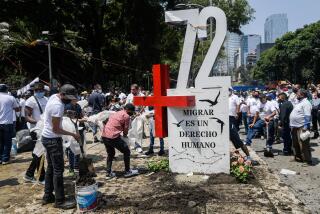Dozens of bodies, many mutilated, dumped in Mexico
MEXICO CITY — Mexican authorities responding to an anonymous tip discovered about 50 mostly mutilated bodies dumped on the side of a highway between Monterrey and the U.S. border, a region where rival gangs are battling for control over a lucrative drug-trafficking corridor.
The bodies of at least 43 men and half a dozen women were found Sunday in plastic garbage bags near the town of Cadereyta Jimenez, the location of a large state-run oil refinery, officials in the state prosecutor’s office told The Times. The exact number of dead was being sorted out, made unclear by the condition of the bodies.
Army and police troops descended on the site and temporarily closed the highway, a major thoroughfare from Monterrey to the border city of Nuevo Laredo.
Jorge Domene, public security spokesman for Nuevo Leon state where the bodies were found, said in a news conference that most of the victims had been decapitated. Their hands and feet also had been chopped off, he said, all of which will complicate the task of identifying the dead.
Judging by tattoos on the bodies, as well as a spray-painted message left alongside them, it seemed likely the victims belonged to a cartel and were killed by rivals, Domene said. The message claimed responsibility for the killings on behalf of the Zetas paramilitary drug gang, he said.
The fight among drug cartels has boiled down largely to a battle between the Zetas, known for their viciousness, and the Sinaloa group, the oldest and largest trafficking network in Mexico. The Zetas once controlled much of northeastern Mexico, but Sinaloa loyalists have steadily moved into the region and allied themselves with the Gulf cartel, a formerly dominant group that created the Zetas but has since turned on them.
More than 50,000 people have been killed in Mexico since President Felipe Calderon launched a military-led assault on powerful drug cartels in December 2006.
Earlier this month, 15 bodies were discovered on the road to Chapala, Mexico, a popular retirement community for U.S. citizens in Jalisco state. And on May 4, 23 bodies — nine hanging from a highway overpass and the other 14 decapitated — were discovered in Nuevo Laredo.
“This discovery is a reflection of actions happening all over the country, like in Nuevo Laredo, and a few weeks ago in Jalisco and a few months ago in Veracruz,” Domene said.
State prosecutor Adrian de la Garza said many of the men and women whose bodies were found Sunday had been dead at least 48 hours and had probably been killed elsewhere and then dumped. He said some of them may have been immigrants or hailed from other parts of the country. Traffickers routinely intercept migrants attempting to reach the United States, force them into labor in drug production or slaughter them for refusing to cooperate.
Many of the bodies were unclothed, and most seemed to be more than 25 years of age, De la Garza said.
Mexicans on July 1 will vote for Calderon’s successor. Election news has largely eclipsed reports on drug-war violence, but in recent weeks the mounting death toll has once again earned front-page coverage — and promises to be very much on voters’ minds going into this summer’s balloting.
The runaway violence, combined with high unemployment, has eroded support for Calderon’s once-dominant National Action Party. Polls show that Enrique Peña Nieto of the Institutional Revolutionary Party, which was driven from power 12 years ago, is the favorite to win the presidency.
Each of the three major candidates has expressed determination to confront the drug cartels and the violence — though none has offered a concrete plan for doing so. The U.S. government has long given its full support to Calderon’s military-led campaign.
The discovery of numerous bodies has become painfully routine in Mexico, with rival gangs often leaving their victims in public venues as a warning to their enemies. In Veracruz, 96 bodies were dumped in public squares and alongside roads in a three-week period last fall, a spate of killing that signaled a campaign by Sinaloa allies to oust the Zetas there.
The violence is part of a war of retribution between Sinaloa and the Zetas, Alejandro Hope, a former Mexican intelligence officer, said in a column Sunday.
“For the criminal groups the game is clear: Take the war to the rival’s territory … heat up the plaza,” Hope said. “They’ve learned that the authorities will follow the bodies, not go where the kill orders are given.”
Also over the weekend, gunmen attacked the offices of a newspaper in Nuevo Laredo. No one was hurt in the Friday evening attack; the newspaper, El Manana, long ago stopped reporting on cartel violence out of fear.
Four current and former journalists were killed in a week’s time this month in the coastal state of Veracruz, including a well-respected investigative reporter who specialized in writing about police corruption and drug trafficking.
More to Read
Sign up for Essential California
The most important California stories and recommendations in your inbox every morning.
You may occasionally receive promotional content from the Los Angeles Times.











